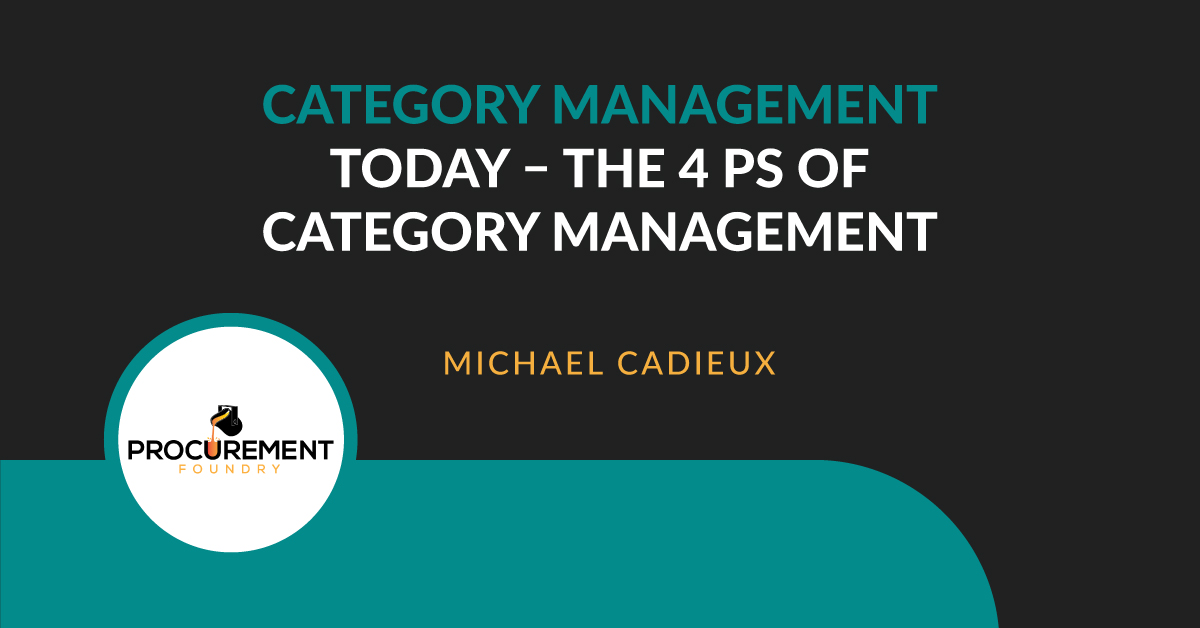Maximizing Savings Opportunities and Procurement's Strategic Value for CPOs
Saving money is not always about pinching pennies: advanced and data-driven insights enable you to identify real cost-saving opportunities, negotiate...
2 min read
![]() Michael Cadieux
:
7/18/22 5:00 AM
Michael Cadieux
:
7/18/22 5:00 AM

Category management today has evolved, and it now requires category managers to fulfill multiple roles—more than ever. So, what exactly are these roles, and how can you, as a category manager, know that you’re hitting the mark?
We discuss the cornerstones (known as the 4 Ps of category management) of being a category manager in today’s modern procurement world to help you ensure you’re staying on target.
Category management requires a specific skill set, including but not limited to managing an assigned group of products. This includes pricing, branding, and promoting these items, with the ultimate goal being sales and money.
To accomplish this ideal goal, building solid relationships with your vendors is critical, as is approaching all tasks with a commercial mindset and being acutely aware of what your customer base wants. It also requires mastering the 4 Ps.
The first P in the 4Ps stands for product. When we talk about product, this encompasses selecting items or offerings you (the retailer) are providing to meet the demands and expectations of your consumers.
A good category manager will be able to deliver products that meet these expectations by expertly wrangling issues of depth and breadth of range, price point management, and much more.
Next, we have price, which refers to the price of the product(s) you’re offering and the price you’re paying your vendors. What this all comes down to is value, right?
We, as consumers, can never just look at the numbers on a price tag and immediately decide whether or not this is a good deal as a purchase. Why? Because we have to weigh everything involved in making the price including risk analysis.
The third P stands for place or placement. This is all about how accessible and appealing your product offering is to consumers.
You are trying to get inside the shoppers’ heads, delve deep into what drives their purchase process—also called the shopper decision framework—and do whatever you need to do to coax that process to a completed sales transaction. Ease is often synonymous with this P, which simply means that the shopper can easily find and choose your product, even among a sea of other products, and without the polite prodding of a salesperson.
Finally, we have promotion. When I think of promoting a product, I think about hype. You want to get your consumers excited about your product offerings, right? Because unless they are enthusiastic about what you’re selling, they’re not buying.
It may surprise you to learn just how personal shopping and the retail world are to many consumers. They want to be involved and engaged. They want to be a part of your world—investing in your product and, by extension, “you” as a brand. In this stage, procurement might work with external departments like marketing.
Here’s a bonus P: people. Despite having a great product, unless you have great talent to keep your procurement processes in check, it will be difficult to remain competitive. High performers are important and assembling an agile and experienced team makes a huge difference.
By mastering these four P’s (and bonus one) of category management, you can truly nail your role as a category manager.
Ready to learn more and get started? Join the Foundry today.

Saving money is not always about pinching pennies: advanced and data-driven insights enable you to identify real cost-saving opportunities, negotiate...

The topic of our recent roundtable discussion with a dozen Procurement Foundry community members—exploring potential flaws in procurement incentive...

Every 30 days or so, I get the same alert on my phone—“Your electricity bill is available for viewing.” I take a quick look, make sure nothing seems...